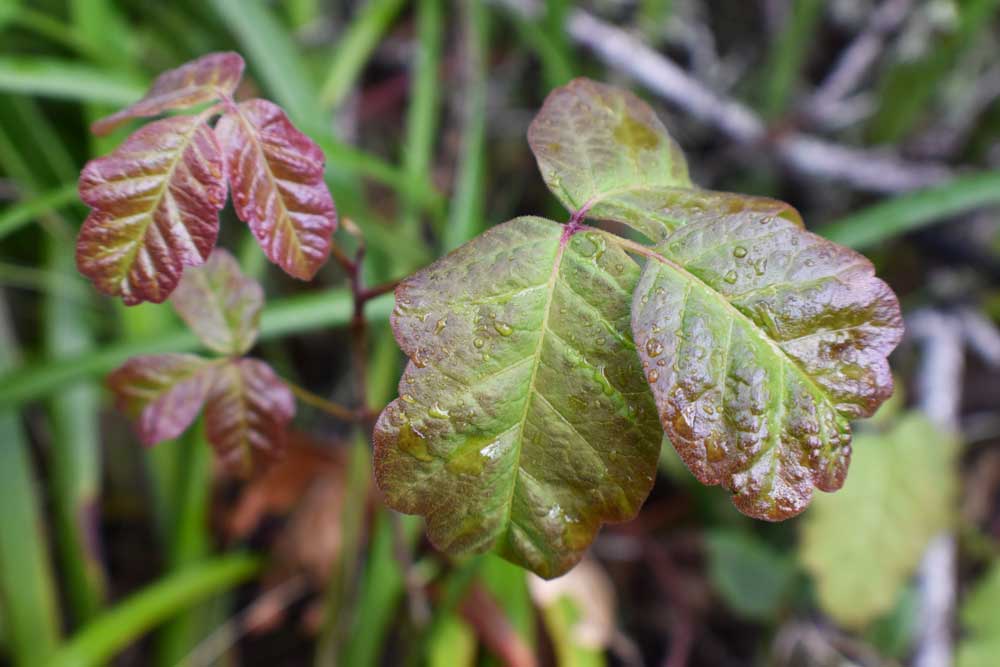Every scoutmaster will teach the scouts how to tell if a spider is poisonous and the easy way to identify poison oak and poison ivy is to remember “Leaves of three, let it be.” This is great advice and will help you identify poison oak and poison ivy.
Not everyone knows that the phrase “Hairy vine, no friend of mine” can help them identify poison oak. Unlike poison ivy, poison oak has hair on both sides of its leaves. Knowing this won’t make you a great scoutmaster, but it will keep you from getting poison oak. Let’s look at other ways to identify and treat poison oak.

Common Enemies
Poison ivy and poison oak have a lot in common; first of all, they both are enemies to our skin. Like poison sumac, both have a toxic oil called urushiol. It is harmful to humans, but normally not toxic to pets.
Both poison ivy and poison oak have three-leaf clusters and look like a small bush or, in some cases, resemble a vine. Both have leaves that change with the seasons from green to orange and often to a dark red and purple color.
Identification Card
Scouts training for hiking are taught that shrub-like plants with clusters of three leaves are poison ivy. If the leaves have hair on both sides, it is poison oak. Both can cause an itchy rash, but they do look like different plants, and it’s important to know how to identify them both.
Poison oak leaves look like that of an oak tree. This is odd since it is not in the oak family. When you think of poison oak, you probably picture an oak tree-like plant. In reality, it is a shrub that grows upright to about three feet.
The fruit of poison oak are called “drupes” and are greenish-white or light tan color. Poison ivy berries are an off-white color. Both grow in clusters and are easy to identify.

We Have Contact
If you know you have come in contact with poison oak, you have about 10 minutes to wash it off. Rinsing your skin with water will not remove the toxic urushiol oil of the poison oak plant. You will need warm water and soap to effectively wash it off. If soap and water are not available, you can use rubbing alcohol or an alcohol pad instead.
In many cases, it’s not just you that has come in contact with poison oak. It’s your clothes, pets and garden tools as well. The oily urushiol toxin can stay on tools for months. It’s not uncommon to borrow a shovel and end up with poison oak, even though you have been nowhere near the plant itself.
If you know you have been exposed to poison oak, you will want to get out of your clothes as soon as possible. Be careful taking them off, or you risk exposing more skin to the urushiol toxin still on your clothes. Your pets are typically not affected by poison oak, but they can have it on their coat. If you think your pet has gotten into poison oak, you should wear rubber gloves and carefully give them a bath.
Over-the-Counter Relief
When the rash, blisters and itching start, it is time to head to the pharmacy. Over-the-counter medicines can provide some relief. Benadryl, cortisone creams and Calamine lotion are good topical treatments. It is a myth that bursting the blisters from a poison oak rash will cause it to spread. However, scratching can lead to infections and, in some cases, scarring.
If topical creams are not enough to stop the itch, try an oatmeal or baking soda bath. The bath can help dry out the rash and give you relief from the itching. In many cases, it takes both topical treatments and baths to get the relief you need.

Doctor Visit
It seems each person reacts to poison oak exposure differently. One person may get a mild rash, and yet another may end up in the emergency room. If you feel faint or are finding it difficult to breathe, you should call 911 right away.
If you are having severe reactions like shortness of breath, fever, extreme pain from the rash, upset stomach or swollen lymph nodes, it’s time to go to the emergency room.
If you have tried everything in the pharmacy and nothing you have found on the internet is stopping the spread, it’s a good bet the rash is getting out of control. If you notice the rash is widespread or it’s getting near your eyes, it’s time to visit the doctor.
Never Ready, Always Prepared
Every good scoutmaster tries to prepare scouts for the dangers that grow in their environment. Like the scouts, those of us who can identify the hairy vine that we call poison oak can avoid contact with it. Even when you do end up with it, knowing what to do can prevent a trip to the emergency room. This may not make you a great scoutmaster, but it can keep you from a nasty rash.
Mossy Oak Wellness products are designed with that singular goal - to help you get the most from your time outdoors. Our passion for helping people get closer to nature has led us to develop innovative, new products built to not only motivate and inspire you to pursue your best life outdoors but to help you feel better while you’re out there.




























